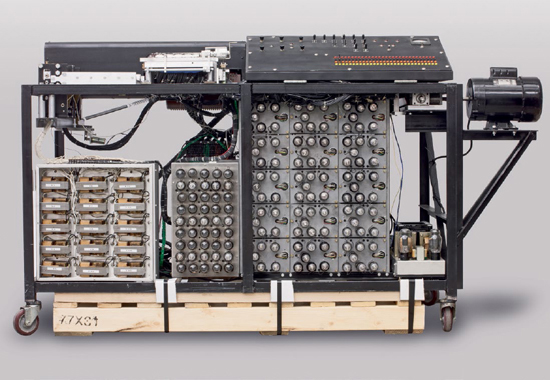1942
Atanasoff-Berry Computer
John Vincent Atanasoff (1903–1995), Clifford Edward Berry (1918–1963)
Built at Iowa State College (now Iowa State University) by professor John Atanasoff and graduate student Clifford Berry, the Atanasoff-Berry Computer (ABC) was an automatic, electronic digital desktop computer.
Atanasoff, a physicist and inventor, created the ABC to solve general systems of linear equations with up to 29 unknowns. At the time, it took a human computer eight hours to solve a system with eight unknowns; systems with more than 10 unknowns were not often attempted. Atanasoff started building the computer in 1937; he successfully tested it in 1942, and then abandoned it when he was called for duty in World War II. Although the machine was largely forgotten, it changed the course of computing decades later.
The machine was based on electronics, rather than relays and mechanical switches, performed math with binary arithmetic, and had a main memory that used an electrical charge (or its absence) in small capacitors to represent 1s and 0s—the same approach used by modern dynamic random access memory (DRAM) modules. The whole computer weighed 700 pounds.
Ironically, the lasting value of the ABC was to invalidate the original ENIAC patent, which had been filed by J. Presper Eckert and John Mauchly in June 1947. The ENIAC patent was the subject of substantial litigation, and the US Patent and Trademark Office did not issue the patent until 1964 as a result. With the patent in hand, the American electronics company Sperry Rand (which had bought the Eckert-Mauchly Computer Corporation in 1950) immediately demanded huge fees from all companies selling computers. At the time, patents were good for 18 years from the date of issuance, meaning that the ENIAC patent might stifle the computing industry until 1982.
It turned out that Mauchly had visited Iowa State and studied the ABC in June 1941—but had failed to mention the ABC as prior work in his patent application. In 1967, Honeywell® sued Sperry Rand, claiming that the patent was invalid because of the omission. The US District Court for the District of Minnesota agreed and invalidated the ENIAC patent six years later.
SEE ALSO ENIAC (1943)
A working reconstruction of the Atanasoff-Berry Computer, built by engineers at Iowa State University between 1994 and 1997.
